by Amélie Godard Palluet & François Lique & Marie Gueguen & Paul Pirlot Jankowiak & Sándor Demes, on
Presentation of the conference

The PCMI National Program is a CNRS/INSU project-based program also supported by CNRS/INP, CNRS/INC, CNES and CEA (www.pcmi.cnrs.fr). It stimulates research between physicists, chemists and astrophysicists to progress in the understanding of the interstellar and circumstellar environments of our galaxy and other galaxies.
Three major questions motivate the program:
(1) the formation of large interstellar structures and their link to star and planet formation,
(2) the role of the interstellar medium in the evolution of our galaxy and nearby and distant galaxies, and
(3) the role of the cycling of matter between phases in the growth of molecular complexity
In addition to the oral presentations, four thematic workshops are organized:
- Cosmic-rays and interstellar medium
- Accounting for the uncertainties, from the laboratory to the observations, through the model
- Prospective for the detection of new molecules in the interstellar medium
- PCMI in the JWST era: physico-chemistry data and models for the exploitation of the observations
This conference is organized by A. Gusdorf, P. Lesaffre, B. Godard, A. Bracco, N. Hayatsu, P. Dell’Ova, A. Vidal-Garcia and T. Richard.
F. Lique was an invited speaker.
S. Demes presented his work in an oral presentation.
M. Gueguen presented her work during the workshop about uncertainties.
A. Godard Palluet, and P. Pirlot Jankowiak shared their results during a poster session.
Collisional excitation of interstellar molecules: towards reactive systems - F. Lique and the COLLEXISM team*
Accurate determination of physical conditions of interstellar molecular clouds is a crucial step to better understand the life cycle of the interstellar matter and particularly the formation of stars and planets. A key parameter for the determination of these conditions from interstellar spectra is the calculation of accurate collisional rate coefficients of interstellar molecules with the most abundant species.
Whereas the knowledge of collisional processes has reached a certain level of maturity for collisions involving non-reactive molecules, very few reliable data exist for collisions involving reactive radicals and ions. The computation of such data is a real challenge since inelastic and reactive processes compete during collisions. In the COLLEXISM project [1], we plan to overcome this complex problem and to provide collisional data for these radicals and ions in order to derive as much information as possible from the molecular spectra collected by current telescopes.
In this talk, I will review the recent results [2-4] we have obtained in this project and I will highlight the theoretical challenges we have overcome [5]. I will also focus on the astrophysical consequences of our new theoretical collisional data. I will emphasis remaining challenges in the field.
*C. Bop, S. Demes, B. Desrousseaux, A. Faure, R. Jara Toro, M. Gueguen, A. Godard Palluet, M. Gontel, P. Hily-Blant, C. Le Guen, M. Leiferman, F. Tonolo, P. Pirlot, M. Żółtowski
[1] https://collexism.com
[2] Demes et al. MNRAS 509, 1252 (2022)
[3] Pirlot et al., J. Chem. Phys. 155, 134303 (2021)
[4] Desrousseaux et al., PCCP 23, 19202 (2021)
[5] Konings et al., J. Chem. Phys. 155, 104302 (2021)
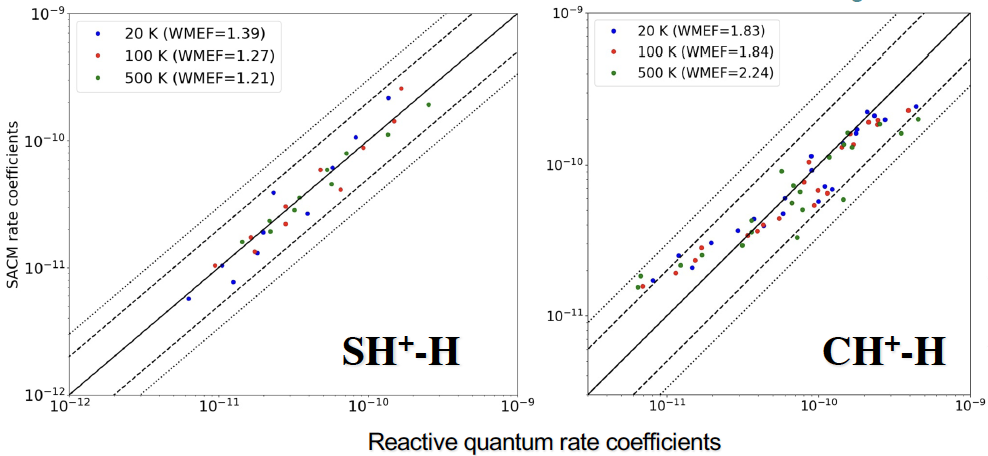
State-of-the-art laboratory experiments combined with quantum chemistry to study reactive ion-molecule collisions under interstellar conditions - S. Demes, S. Carles, A. Mortada, R. Jara Toro, B. Joalland, A. Benidar, F. Lique and L. Biennier
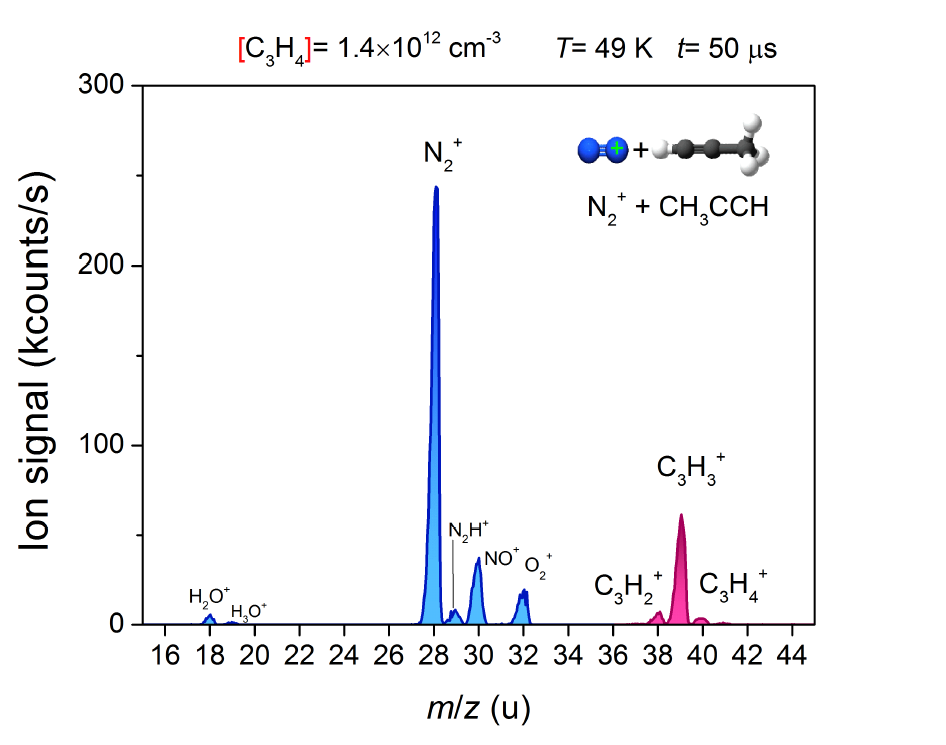
Astronomical observations have revealed a rich chemical complexity in the close galactic molecular clouds of the interstellar medium (ISM) [1]. So far, more than 250 molecules have been detected in these environments. Most of them are stable neutral species, but there is plenty of radicals and molecular ions among them as well. The variety of the observed cations has grown rapidly in recent years, with the detection of species like ArH+, C3H+, C2N2H+, NO+, NS+, etc. While the majority of the neutral interstellar species are not highly reactive, the ionic species are usually efficiently involved in chemical reactive processes and thus initiate – or contribute to - the growth of molecular complexity. The study of reactive collisions however induces many challenges both from experimental as well as from theoretical side. What is the nature and internal state of the reaction products? What is their relative abundance? What kind of side species and isomers are formed? To understand the reactive molecular processes and answer these questions, a global approach is required, which involves state-of-the-art laboratory measurements from one hand along with in-depth theoretical analysis of the reaction kinetics on the other hand. At Institut de Physique de Rennes, we have realized this unique combination of experimental and theoretical methods to investigate reactive ion–molecule collisions.
In our laboratory, we have developed an original method which combines a uniform supersonic flow reactor (CRESU) apparatus with a mass-selective source capable to produce stable ionic species at thermal energies (down to about 10 K) [2]. The apparatus is equipped with a quadrupole mass spectrometer which allows the detection of ionic products in the range of 0-100 amu in reactive collisions between molecular ions and neutral species [2]. In parallel, we combine high-level ab initio theories with molecular dynamics and transition state theory-based methods to explore the possible reaction paths and calculating reaction rates for the individual channels. The association of such experimental and theoretical tools allows one to follow reaction kinetics and derive precise branching ratios. We have recently studied the reaction of N2+ with C3H4 [3] and of Ar+ with C2H4, where for both of them we found a significant temperature dependence of the branching ratios. These findings initiate further investigation of ion–molecule collisions. We have now started to examine key interstellar reactions for rapid carbon chain elongation (i.e. all C atoms end up in the products) such as the one of CH3+ with a range of hydrocarbons.
[1] E. Roueff Applications: the Molecular Viewpoint of Interstellar Observations in Gas-Phase Chemistry in Space ed. F. Lique & A. Faure (IOP Publishing, Bristol, UK, 2019).
[2] B. Joalland, N. Jamal-Eddine, D. Papanastasiou, A. Lekkas, S. Carles, and L. Biennier, J. Chem. Phys. 150, 164201 (2019).
[3] A. Mortada, S. Carles, S. Demes, B. Joalland, F. Lique, A. Benidar, P. Lavvas, and L. Biennier, ACS Earth Space Chem. 6, 1227–1238 (2022).
Why uncertainties are so instrumental? A philosopher's viewpoint - M. Gueguen
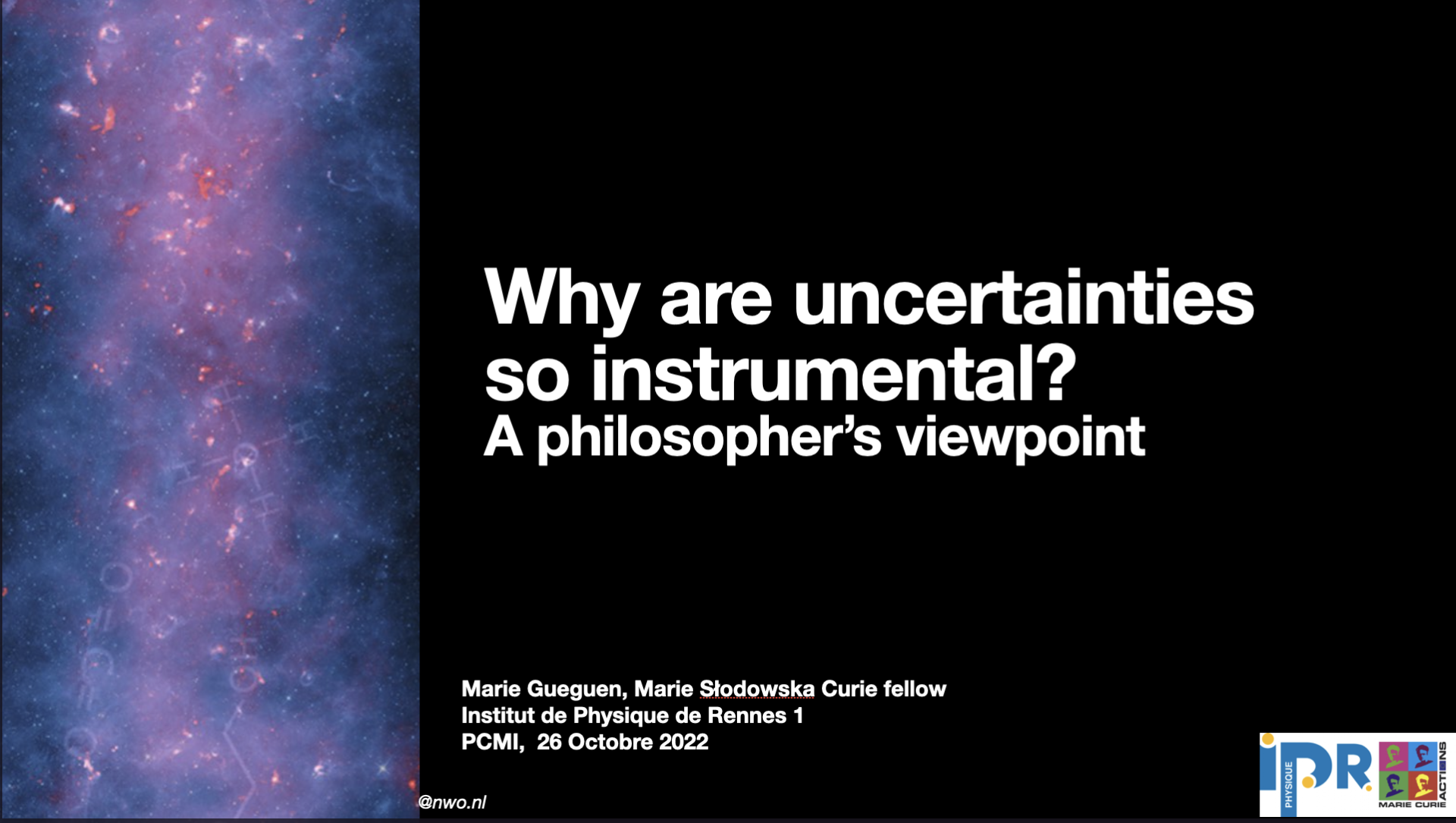
An accurate estimate of the uncertainties is essential in all empirical sciences. Yet, when using a model to interpret observations, there are numerous layers of uncertainties that affect the final estimate of the physical quantities, and that are difficult to track and account for. This is particularly important for ISM studies, as our models often contain microphysical quantities that have been measured in the laboratory (cross-sections, reaction rates, etc.) and are put into a radiative transfer framework. In addition, observations are frequently corrected using external models that have their own set of assumptions and errors (extinction correction, contamination subtraction, etc.). Overall, improperly estimated uncertainties could change the outcome of a study and jeopardize our assessment of the reality of a phenomenon. This will become more important in the future, as we will see an increase in the accuracy of measurements, in the amount of heterogeneous data to analyze and in the complexity of models.
The excitation of ethynyl in the interstellar medium : A key to understand isotopic fractionation - P. Pirlot Jankowiak, P. J. Dagdigian and F. Lique
Since the discovery of the ethynyl CCH radical in the interstellar medium [1], it has been detected in a wide range of astrophysical environments. It is one of the most abundant hydrocarbon in space and together with its detected isotopologues (CCD, 13CCH and C13CH), they are useful tracers of physical conditions. Indeed, as abundances strongly depend on the formation pathways, the measurment for the ratio [CCD]/[CCH] may constrain the age of molecular clouds in astrophysical models [2]. However, hyperfine resolved 13C-based spectra show a higher intensity in favor of C13CH lines than 13CCH ones [3, 4] whereas their formation path is supposed to be the same. It is then of high interest to investigate this apparent different abundance of the two isotopologues.
An accurate interpretation of these observations requires to determine precise rate coefficients. Such quantities are necessary for non local thermodynamic equilibrium modeling which takes into account competition between radiative and collisional processes.
Non zero nuclear spins from 13C, D and H atoms lead to a resolved hyperfine structure for these species.
Such complex energetic structure is a real theoretical challenge as exact scattering calculations are not feasible in a reasonable time. Then, it is necessary to develop numerical and methodological tools in order to determine accurate collisional data for astrophysical applications. In this study, I present the calculations of new accurate collisional data for all the CCH isotopologues.
Scattering calculations have been performed using a recoupling technique in order to determine accurate hyperfine resolved rate coefficients of CCH and its isotopologues in collision with H2. These data were derived for a large range of temperature and are expected to improve abundance ratio calculations and better understand the evolution of the isotopic fraction in astrochemical models.
[1] K. D. Tucker, M. L. Kutner, and P. Thaddeus, The Astrophysical Journal 193, 115 (1974).
[2] S. P. Trevino-Morales, P. Pilleri, A. Fuente, C. Kramer, E. Roueff, M. Gonzalez-Garcia, J. Cernicharo, M.
Gerin, J. R. Goicoechea, J. Pety, O. Berné, V. Ossenkopf, D. Ginard, S. Garcia-Burillo, J. R. Rizzo, and S.
Viti, A&A 569 (2014).
[3] S. Cuadrado, J. R. Goicoechea, P. Pilleri, J. Cernicharo, A. Fuente, and C. Joblin, A&A 575 (2015).
[4] N. Sakai, O. Saruwatari, T. Sakai, S. Takano, and S. Yamamoto, A&A 512 (2010).
[5] A. Spieldiedel, N. Feautrier, F. Najar, D. Ben Abdallah, F. Dayou, M. L. Senent, and F. Lique, Mon. Not.
R. Astronom. Soc. 421, 1891 (2012).
[6] F. Dumouchel, F. Lique, A. Spieldiedel, and N. Feautrier, Mon. Not. R. Astronom. Soc. 471, 1849 (2017).
[7] P. J. Dagdigian, Mon. Not. R. Astronom. Soc. 479, 3227 (2018).
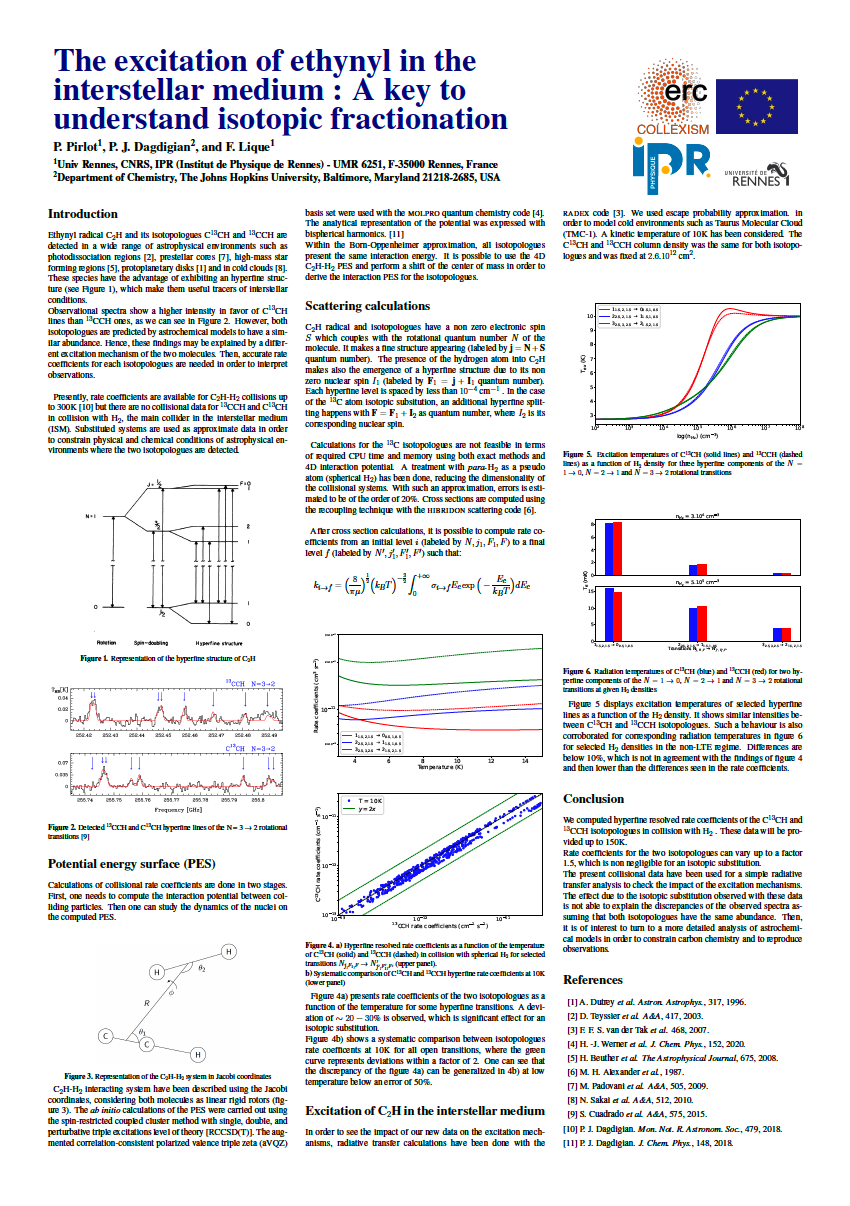
Fine and hyperfine excitation of CCS isotopologues induced by collisions with He - A. Godard Palluet , F. Lique
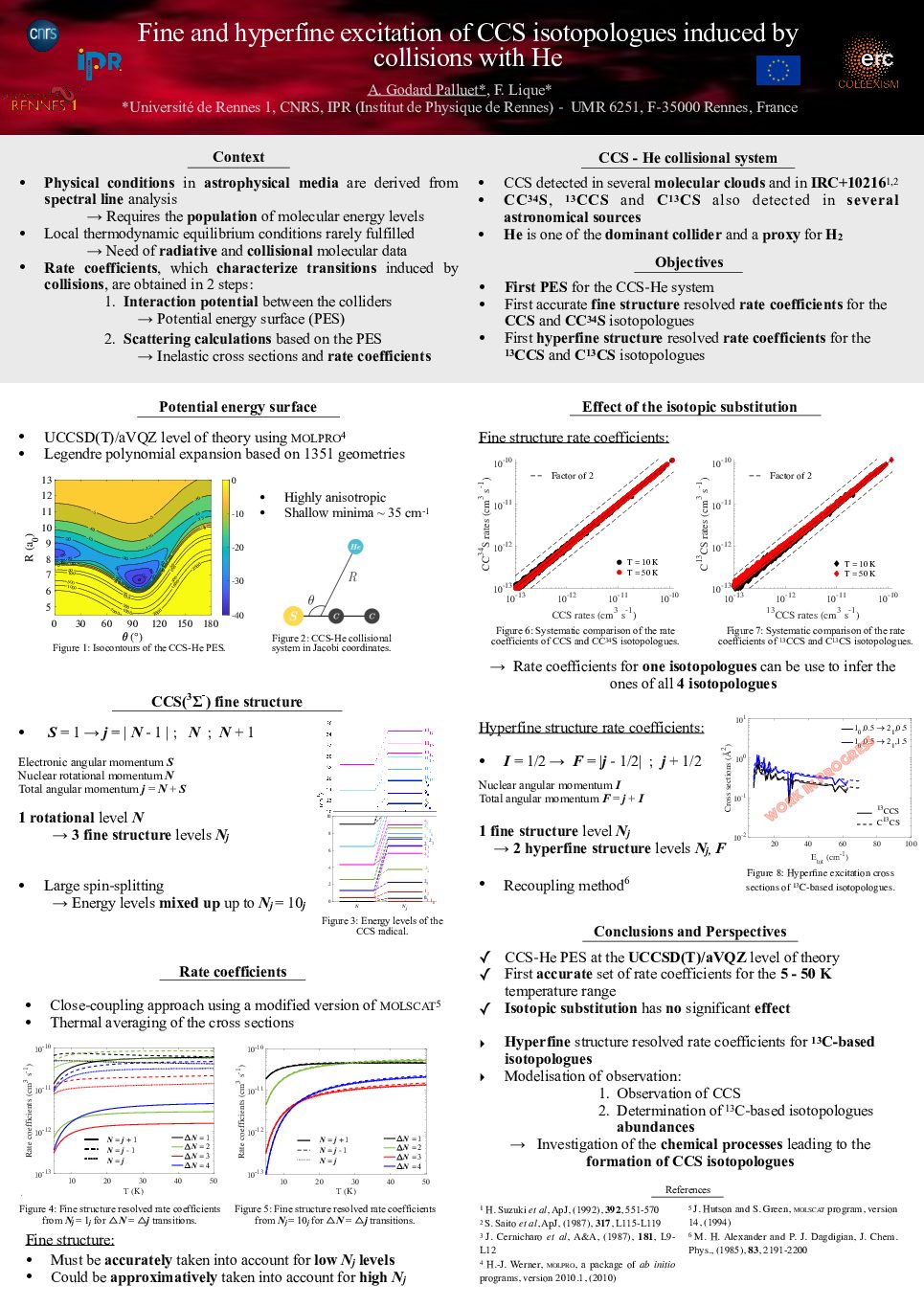
The physical conditions in space are derived from the spectra captured by telescopes. The spectral analysis requires to know the population of molecular energy levels. However, the local thermodynamic equilibrium conditions are rarely fulfilled in astrophysical media. Hence, the population of energy levels and the intensity of spectral lines are determined with a radiative transfer model that takes both radiative and collisional processes into account. Radiative transitions are characterized by Einstein’s coefficients, for which analytical formula exist, and collisional transitions are characterized by rate coefficients. The later are system-specific, and their determination in laboratory are extremely difficult. Therefore, radiative transfer model relies almost exclusively on theoretical estimates [1]. They are preferentially obtained from scattering calculations performed on a potential energy surface (PES) which describe the electronic interaction between the two colliders.
The CCS(3Σ−) radical and its isotopologues have been detected in several dark molecular clouds, including TMC-1 and also in the circumstellar enveloppe IRC+10216. However, their rate coefficients do not exist in the literature and astrophysicists use rates from OCS to infer the one of CCS isotopologues [2]. However, the CCS radical presents a large fine structure splitting, which makes the estimation of the rate coefficients incorrect and the line modelisation difficult [3]. Therefore, the CCS rate coefficients must be accurately determined.
During this presentation, the PES used for the close-coupling scattering calculations will be presented. It was obtained with the gold standard UCCSD(T) method and an aVQZ basis set with additional mid-bond functions. The first accurate fine state-to-state rate coefficients for the 5 - 50 K temperature range of the 12C12C32S isotopologue will be presented. These rates were also computed for the 13C12C32S, 12C13C32S and 12C12C34S isotopologues, including the hyperfine structure for 13C-based isotopologues. The isotopic effect on the fine and hyperfine structure resolved rate coefficients will be discussed.
[1] J. Loreau, F. Lique and A. Faure, ApJ., 853 L5 (2018).
[2] H. Suzuki, S. Yamamoto, M. Ohishi, N. Kaifu, S. Ishikawa, Y. Hirahara, S. Takano, ApJ., 392 551 (1992).
[3] S. Saito, K. Kawaguchi, S. Yamamoto, M. Ohishi, H. Suzuki, N. Kaifu, ApJ., 317 L115 (1987).
[4] J. Cernicharo, M. Guélin, H. Hein, C. Kahane, A&A, 181 L9 (1987).
[5] M. Ikeda, Y. Sekimoto, S. Yamamoto, J. Mol. Spectrosc., 185 21 (1997).